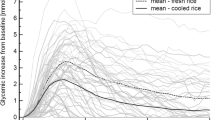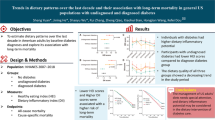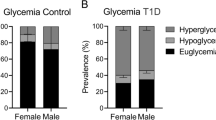Abstract
The Dietary Approaches to Stop Hypertension (DASH) diet is rich in foods (fruits, vegetables, whole grains) that may reduce hyperglycemia and glycemic variability. In this randomized crossover feeding trial, 89 participants with type 2 diabetes were fed four isocaloric diets in a random order: the DASH4D diet (a DASH-style diet tailored for diabetes) or a comparison (typical American) diet, each with higher (3,700 mg day−1 at 2,000 kcal) or lower (1,500 mg day−1 at 2,000 kcal) sodium. Each feeding period lasted 5 weeks. The primary outcomes were mean glucose; percentage of time spent with glucose between 70 and 180 mg dl−1 (time in range); and coefficient of variation assessed using 14 days of continuous glucose monitoring during each feeding period. The DASH4D (versus comparison) diet significantly reduced mean glucose (mean difference = −11.1 mg dl−1; P < 0.001), increased time in range (mean difference = +5.2 percentage points; P < 0.001) and had no effect on the coefficient of variation (P = 0.52). In analyses of secondary outcomes, glucose standard deviation and time spent with hyperglycemia (glucose >180 mg dl−1 and >250 mg dl−1) were lower in the DASH4D diet, but time spent with hypoglycemia (glucose <70 mg dl−1 and <54 mg dl−1) was similar across diets. There were no serious adverse events related to continuous glucose monitoring or the study diets. These results suggest that the DASH4D diet is a promising nutritional approach to substantially improve glycemic control in adults with type 2 diabetes. ClinicalTrials.gov registration: NCT04286555.
This is a preview of subscription content, access via your institution
Access options
Access Nature and 54 other Nature Portfolio journals
Get Nature+, our best-value online-access subscription
$32.99 / 30 days
cancel any time
Subscribe to this journal
Receive 12 print issues and online access
$259.00 per year
only $21.58 per issue
Buy this article
- Purchase on SpringerLink
- Instant access to full article PDF
Prices may be subject to local taxes which are calculated during checkout




Similar content being viewed by others
Data availability
Requests for access to the DASH4D data may be submitted to the DASH4D Publications Committee according to established study procedures. This includes submission of a completed manuscript proposal to the Publications Committee (email to eselvin@jh.edu). The Publications Committee will evaluate all proposals for scientific merit and access will be granted after approval of the proposal and completion of a data transfer agreement. Review of proposals may take up to 1 month.
Code availability
No custom code was developed for this study. All analyses were performed using Stata v.18. Researchers interested in the analytical code can contact the corresponding author (eselvin@jh.edu). Requests should include a description of the goals and rationale of the research project, and the analyses researchers plan to conduct. Review of code requests may take up to 1 month.
References
UK Prospective Diabetes Study (UKPDS) Group. Intensive blood-glucose control with sulphonylureas or insulin compared with conventional treatment and risk of complications in patients with type 2 diabetes (UKPDS 33). Lancet 352, 837–853 (1998).
UK Prospective Diabetes Study (UKPDS) Group. Effect of intensive blood-glucose control with metformin on complications in overweight patients with type 2 diabetes (UKPDS 34). Lancet 352, 854–865 (1998).
Ohkubo, Y. et al. Intensive insulin therapy prevents the progression of diabetic microvascular complications in Japanese patients with non-insulin-dependent diabetes mellitus: a randomized prospective 6-year study. Diabetes Res. Clin. Pract. 28, 103–117 (1995).
Fang, M., Wang, D., Coresh, J. & Selvin, E. Trends in diabetes treatment and control in US adults, 1999–2018. N. Engl. J. Med. 384, 2219–2228 (2021).
Evert, A. B. et al. Nutrition therapy for adults with diabetes or prediabetes: a consensus report. Diabetes Care 42, 731–754 (2019).
ElSayed, N. A. et al. Facilitating positive health behaviors and well-being to improve health outcomes: standards of care in diabetes—2025. Diabetes Care 48, S86–S127 (2025).
Appel, L. J. et al. A clinical trial of the effects of dietary patterns on blood pressure. N. Engl. J. Med. 336, 1117–1124 (1997).
Sacks, F. M. et al. Effects on blood pressure of reduced dietary sodium and the Dietary Approaches to Stop Hypertension (DASH) diet. N. Engl. J. Med. 344, 3–10 (2001).
Appel, L. J. et al. Effects of protein, monounsaturated fat, and carbohydrate intake on blood pressure and serum lipids: results of the OmniHeart randomized trial. JAMA 294, 2455–2464 (2005).
Arnett, D. K. et al. 2019 ACC/AHA guideline on the primary prevention of cardiovascular disease: a report of the American College of Cardiology/American Heart Association Task Force on Clinical Practice Guidelines. J. Am. Coll. Cardiol. 74, e177–e232 (2019).
McEvoy, J. W. et al. 2024 ESC Guidelines for the management of elevated blood pressure and hypertension: developed by the task force on the management of elevated blood pressure and hypertension of the European Society of Cardiology (ESC) and endorsed by the European Society of Endocrinology (ESE) and the European Stroke Organisation (ESO). Eur. Heart J. 45, 3912–4018 (2024).
Cheung, A. K. et al. KDIGO 2021 clinical practice guideline for the management of blood pressure in chronic kidney disease. Kidney Int. 99, S1–S87 (2021).
Akhlaghi, M. Dietary Approaches to Stop Hypertension (DASH): potential mechanisms of action against risk factors of the metabolic syndrome. Nutr. Res. Rev. 33, 1–18 (2020).
Glenn, A. J. et al. Longitudinal changes in adherence to the portfolio and DASH dietary patterns and cardiometabolic risk factors in the PREDIMED-Plus study. Clin. Nutr. 40, 2825–2836 (2021).
Paula, T. P. et al. Effects of the DASH diet and walking on blood pressure in patients with type 2 diabetes and uncontrolled hypertension: a randomized controlled trial. J. Clin. Hypertens. 17, 895–901 (2015).
Azadbakht, L. et al. Effects of the Dietary Approaches to Stop Hypertension (DASH) eating plan on cardiovascular risks among type 2 diabetic patients: a randomized crossover clinical trial. Diabetes Care 34, 55–57 (2011).
Jannasch, F., Kröger, J. & Schulze, M. B. Dietary patterns and type 2 diabetes: a systematic literature review and meta-analysis of prospective studies. J. Nutr. 147, 1174–1182 (2017).
Chiavaroli, L. et al. DASH dietary pattern and cardiometabolic outcomes: an umbrella review of systematic reviews and meta-analyses. Nutrients 11, 338 (2019).
ElSayed, N. A. et al. 7. Diabetes technology: standards of care in diabetes—2024. Diabetes Care 47, S126–S144 (2024).
Ceriello, A., Monnier, L. & Owens, D. Glycaemic variability in diabetes: clinical and therapeutic implications. Lancet Diabetes Endocrinol. 7, 221–230 (2019).
Gilliam, L. K., Parker, M. M., Moffet, H. H., Lee, A. K. & Karter, A. J. Continuous glucose monitor metrics are associated with emergency department visits and hospitalizations for hypoglycemia and hyperglycemia, but have low predictive value. Diabetes Technol. Ther. 26, 298–306 (2024).
Lu, J. et al. Time in range in relation to all-cause and cardiovascular mortality in patients with type 2 diabetes: a prospective cohort study. Diabetes Care 44, 549–555 (2021).
Raj, R. et al. Time in range, as measured by continuous glucose monitor, as a predictor of microvascular complications in type 2 diabetes: a systematic review. BMJ Open Diabetes Res. Care 10, e002573 (2022).
Pilla, S. J. et al. Dietary patterns, sodium reduction, and blood pressure in type 2 diabetes: The DASH4D Randomized Clinical Trial. JAMA Intern Med. https://doi.org/10.1001/jamainternmed.2025.1580 (2025).
Goff, H. D., Repin, N., Fabek, H., El Khoury, D. & Gidley, M. J. Dietary fibre for glycaemia control: towards a mechanistic understanding. Bioact. Carbohydr. Diet. Fibre 14, 39–53 (2018).
Silva, F. M. et al. Fiber intake and glycemic control in patients with type 2 diabetes mellitus: a systematic review with meta-analysis of randomized controlled trials. Nutr. Rev. 71, 790–801 (2013).
Mao, T., Huang, F., Zhu, X., Wei, D. & Chen, L. Effects of dietary fiber on glycemic control and insulin sensitivity in patients with type 2 diabetes: a systematic review and meta-analysis. J. Funct. Foods 82, 104500 (2021).
Reynolds, A. N., Akerman, A. P. & Mann, J. Dietary fibre and whole grains in diabetes management: systematic review and meta-analyses. PLoS Med. 17, e1003053 (2020).
Reynolds, A. et al. Carbohydrate quality and human health: a series of systematic reviews and meta-analyses. Lancet 393, 434–445 (2019).
Åberg, S., Mann, J., Neumann, S., Ross, A. B. & Reynolds, A. N. Whole-grain processing and glycemic control in type 2 diabetes: a randomized crossover trial. Diabetes Care 43, 1717–1723 (2020).
Battelino, T. et al. Continuous glucose monitoring and metrics for clinical trials: an international consensus statement. Lancet Diabetes Endocrinol. 11, 42–57 (2023).
Beck, R. W. et al. Validation of time in range as an outcome measure for diabetes clinical trials. Diabetes Care 42, 400–405 (2019).
Vigersky, R. A. & McMahon, C. The relationship of hemoglobin A1C to time-in-range in patients with diabetes. Diabetes Technol. Ther. 21, 81–85 (2019).
Harnden, K., Frayn, K. & Hodson, L. Dietary Approaches to Stop Hypertension (DASH) diet: applicability and acceptability to a UK population. J. Hum. Nutr. Diet. 23, 3–10 (2010).
Baker, E. A., Barnidge, E. K., Schootman, M., Sawicki, M. & Motton-Kershaw, F. L. Adaptation of a modified DASH diet to a rural African American community setting. Am. J. Prev. Med. 51, 967–974 (2016).
Kim, H., Song, H.-J., Han, H.-R., Kim, K. B. & Kim, M. T. Translation and validation of the dietary approaches to stop hypertension for Koreans intervention: culturally tailored dietary guidelines for Korean Americans with high blood pressure. J. Cardiovasc. Nurs. 28, 514–523 (2013).
Filippou, C. D. et al. Dietary Approaches to Stop Hypertension (DASH) diet and blood pressure reduction in adults with and without hypertension: a systematic review and meta-analysis of randomized controlled trials. Adv. Nutr. 11, 1150–1160 (2020).
Theodoridis, X. et al. Adherence to the DASH diet and risk of hypertension: a systematic review and meta-analysis. Nutrients 15, 3261 (2023).
Whitt-Glover, M. C. et al. Translating the Dietary Approaches to Stop Hypertension (DASH) diet for use in underresourced, urban African American communities, 2010. Prev. Chronic Dis. 10, 120088 (2013).
FreeStyle Libre Pro Flash Glucose Monitoring System. US Food and Drug Administration www.accessdata.fda.gov/scripts/cdrh/cfdocs/cfpma/pma.cfm?id=P150021 (2016).
FreeStyle Libre 3 Continuous Glucose Monitoring System. 510(k) substantial equivalence determination decision summary. US Food and Drug Administration www.accessdata.fda.gov/cdrh_docs/reviews/K212132.pdf (2022).
Li, G. et al. Exploring ethnic representativeness in diabetes clinical trial enrolment from 2000 to 2020: a chronological survey. Diabetologia 65, 1461–1472 (2022).
Dietary Approaches to Stop Hypertension for Diabetes (DASH4D). ClinicalTrials.gov https://clinicaltrials.gov/study/NCT04286555?a=12 (2024).
Wang, D. et al. Design of the continuous glucose monitoring (CGM) study in the Dietary Approaches to Stop Hypertension for Diabetes Trial (DASH4D-CGM). Contemp. Clin. Trials 151, 107845 (2025).
ElSayed, N. A. et al. 5. Facilitating positive health behaviors and well-being to improve health outcomes: standards of care in diabetes—2024. Diabetes Care 47, S77–S110 (2024).
National Academies of Sciences Engineering and Medicine. Dietary Reference Intakes for Sodium and Potassium (National Academies Press, 2019); https://doi.org/10.17226/25353
Nutritional Intakes from Food and Beverages: Mean Amounts Consumed per Individual, by Gender and Age. What We Eat in America, NHANES 2013–2014 (US Department of Agriculture, 2016); www.ars.usda.gov/arsuserfiles/80400530/pdf/1314/table_1_nin_gen_13.pdf
Nutritional Intakes from Food and Beverages: Mean Amounts Consumed per Individual, by Gender and Age. What We Eat in America, NHANES 2015–2016 (US Department of Agriculture, 2018); https://www.ars.usda.gov/arsuserfiles/80400530/pdf/1516/table_1_nin_gen_15.pdf
McClure, S. T. et al. Dietary intake of adults with and without diabetes: results from NHANES 2013–2016. BMJ Open Diabetes Res. Care 8, e001681 (2020).
Whelton, P. K. et al. 2017 ACC/AHA/AAPA/ABC/ACPM/AGS/APhA/ASH/ASPC/NMA/PCNA guideline for the prevention, detection, evaluation, and management of high blood pressure in adults: a report of the American College of Cardiology/American Heart Association Task Force on Clinical Practice Guidelines. J. Am. Coll. Cardiol. 71, e127–e248 (2018).
Abbott. About Freestyle Libre Pro. Vol. 2024 (2023); https://www.freestyle.abbott/in-en/libre-pro.html
ElSayed, N. A. et al. Glycemic goals and hypoglycemia: standards of care in diabetes—2024. Diabetes Care 47, S111–S125 (2024).
Battelino, T. et al. Continuous glucose monitoring and metrics for clinical trials: an international consensus statement.Lancet Diabetes Endocrinol. 11, 42–57 (2023).
Bergenstal, R. M. et al. Glucose management indicator (GMI): a new term for estimating A1C from continuous glucose monitoring. Diabetes Care 41, 2275–2280 (2018).
Klonoff, D. C. et al. A glycemia risk index (GRI) of hypoglycemia and hyperglycemia for continuous glucose monitoring validated by clinician ratings. J. Diabetes Sci. Technol. 17, 1226–1242 (2023).
Patel, S. M. et al. Dietary sodium reduction does not affect circulating glucose concentrations in fasting children or adults: findings from a systematic review and meta-analysis. J. Nutr. 145, 505–513 (2015).
Brown, S. A. et al. Six-month randomized, multicenter trial of closed-loop control in type 1 diabetes. N. Engl. J. Med. 381, 1707–1717 (2019).
Ware, J. et al. Randomized trial of closed-loop control in very young children with type 1 diabetes. N. Engl. J. Med. 386, 209–219 (2022).
Russell, S. J. et al. Multicenter, randomized trial of a bionic pancreas in type 1 diabetes. N. Engl. J. Med. 387, 1161–1172 (2022).
Acknowledgements
The DASH4D parent trial was funded principally by the Sheikh Khalifa Stroke Institute at Johns Hopkins University School of Medicine, with support from the Johns Hopkins O’Brien Center to Advance Kidney Health Equity, the National Institute of Diabetes and Digestive and Kidney Diseases (NIDDK) (grant no. U54DK137331) and the Johns Hopkins Institute for Clinical and Translational Research, funded by the National Center for Advancing Translational Sciences through the Clinical and Translational Science Awards Program (grant no. 1UM1TR004926). The DASH4D-CGM ancillary study was supported by an NIDDK grant (no. R01DK128900) awarded to E.S. S.J.P. was supported by an NIDDK career development award (no. K23DK128572). M.F. was supported by an NIDDK career development award (no. K01DK138273). O.T. was supported by a National Heart, Lung, and Blood Institute (NHLBI) training grant (no. T32HL007024). J.B.E.-T. was supported by an NHLBI career development grant (no. K23HL153774). The funders had no role in the design and conduct of the study; the collection, management, analysis and interpretation of the data; the preparation, review or approval of the manuscript; or the decision to submit the manuscript for publication. The content is solely the responsibility of the authors and does not necessarily represent the official views of the National Institutes of Health. Abbott Diabetes Care provided the CGM systems for this investigator-initiated research. We thank the participants and study staff for their contributions to the DASH4D trial. We also thank S. Arul for designing the graphics for the study meals. We thank members of the DASH4D Collaborative Research Group. Johns Hopkins University: L. J. Appel, S. J. Pilla, H.-C. Yeh, N. Durkin, J. Echouffo Tcheugui, M. Fang, M. Lu, N. M. Maruthur, E. R. Miller 3rd, C. M. Mitchell, S. Oh, J. Sartini, E. Selvin, A. A. Stein, J. Trost, D. Wang, N.-Y. Wang and S. Zeger. Johns Hopkins ProHealth Clinical Research Unit: C. Abbas, P. Bayton, A. Bender, J. Charleston, I. Glenn-Smith, T. Harrison, X. Hu, S. Jackson, D. Jiggetts, M. Johnson, A. Sabie, C. Sapun, H. Schlechter, X. Shen, V. Sneed, P. Stoykov, A. Terry, L. Thomas, I. Wang, K. White and B. Wu. External Co-Investigators: S. P. Juraschek (Beth Israel Deaconess Medical Center) and N. T. Mueller (University of Colorado Anschutz Medical Campus). Data and Safety Monitoring Board: F. Sacks (Chair, Harvard T.H. Chan School of Public Health), V. Fonseca (Tulane University School of Medicine) and W. Vollmer (Kaiser Permanente Center for Health Research). E.S. was supposed by a Merit Award from the American Heart Association.
Author information
Authors and Affiliations
Contributions
M.F. and D.W. had full access to all the data in the study and take responsibility for the integrity of the data and the accuracy of the data analysis. M.F., E.S. and O.T. conceptualized and designed the study. M.F. and E.S. acquired, analyzed or interpreted the data. D.W. and N.-Y.W. carried out the statistical analysis. L.J.A., C.M.M. and E.S. provided administrative, technical or material support. L.J.A. and E.S. supervised the study. M.F. drafted the manuscript. All authors critically revised the manuscript for important intellectual content.
Corresponding author
Ethics declarations
Competing interests
The authors declare no competing interests.
Peer review
Peer review information
Nature Medicine thanks Shilpa Bhupathiraju, Linong Ji and the other, anonymous, reviewer(s) for their contribution to the peer review of this work. Primary Handling Editor: Ming Yang, in collaboration with the Nature Medicine team.
Additional information
Publisher’s note Springer Nature remains neutral with regard to jurisdictional claims in published maps and institutional affiliations.
Extended data
Supplementary information
Supplementary Information
Supplementary Tables 1–3, Statistical analysis plan, Study protocol and CONSORT checklist.
Rights and permissions
Springer Nature or its licensor (e.g. a society or other partner) holds exclusive rights to this article under a publishing agreement with the author(s) or other rightsholder(s); author self-archiving of the accepted manuscript version of this article is solely governed by the terms of such publishing agreement and applicable law.
About this article
Cite this article
Fang, M., Wang, D., Rebholz, C.M. et al. DASH4D diet for glycemic control and glucose variability in type 2 diabetes: a randomized crossover trial. Nat Med (2025). https://doi.org/10.1038/s41591-025-03823-3
Received:
Accepted:
Published:
DOI: https://doi.org/10.1038/s41591-025-03823-3



